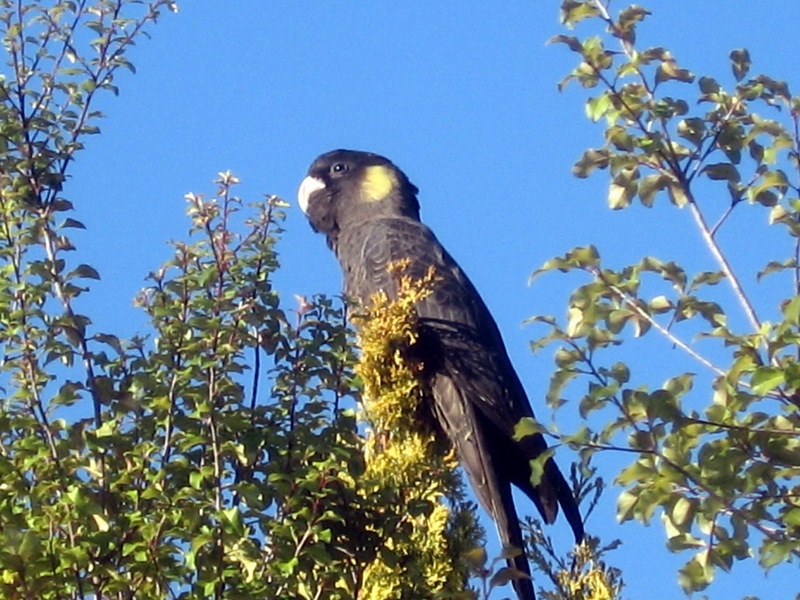|
| Query: Pine caterpillar | Result: 65th of 68 | |
Yellow-tailed Black Cockatoo (Calyptorhynchus funereus) - Wiki
| Subject: | Yellow-tailed Black Cockatoo (Calyptorhynchus funereus) - Wiki
| |

| Resolution: 1296x972
File Size: 440112 Bytes
Date: 2006:06:19 16:13:05
Camera: Canon PowerShot A530 (Canon)
F number: f/5.5
Exposure: 1/160 sec
Focal Length: 23200/1000
Upload Date: 2007:09:20 16:12:19
|
Yellow-tailed Black Cockatoo
From Wikipedia, the free encyclopedia
[Photo] A Yellow-Tailed Black Cockatoo in Melbourne, Australia. Date: 19 June 2006. Photo by http://en.wikipedia.org/wiki/User:Skyscraper297 | Permission is granted to copy, distribute and/or modify this document under the terms of the GNU Free Documentation License, Version 1.2 or any later version published by the Free Software Foundation; with no Invariant Sections, no Front-Cover Texts, and no Back-Cover Texts. A copy of the license is included in the section entitled "GNU Free Documentation License". |
The Yellow-tailed Black Cockatoo, Calyptorhynchus funereus, is a large cockatoo native to the south-east of Australia. It is found from Eyre Peninsula to south and central eastern Queensland. In some places at least, they appear to have adapted to humans and can be often seen in many parts of urban Sydney and Melbourne.
Although not particularly common, they are one of the most well-loved and characteristic birds of southern Australia. They are usually seen flying at only moderate height. They have particularly large wings and flap deeply, very slowly, and with a peculiar heavy, fluid motion. Their loud, eerie wailing calls carry for long distances, and the combination of sound and silhouette is unmistakable.
Taxonomy and naming
The Yellow-tailed Black Cockatoo was first described by the English naturalist George Shaw. The current genus name, Calyptorhynchus, comes from the Greek calypto-/καλυπτο- "hidden" and rhynchus/ρυγχο?? "beak". The change was first made by Anselme Ga??tan Desmarest in 1826.
Description
Adult birds are between 55 and 65 cm in length, black overall with paler feather-margins and patches of pale yellow in the tail. The male bird (illustrated at right) has a black bill, a dull yellow patch behind the eye, and a reddish eye-ring. Females and immatures have a grey eye-ring, a light-coloured bill, and a brighter, more clearly-defined yellow cheek-patch.
Behaviour
Diet
Their natural food is varied, but much of the diet comprises seeds of native trees, particularly she-oak (Casuarina) but also Eucalyptus, Acacia, Banksia and Hakea. They are also partial to pine cones in plantations of the introduced Pinus radiata. They are very fond of the larvae of tree-boring beetles and moths, and strip the bark from the trees and tear away at the wood to find them.
Reproduction
The yellow-tailed black cockatoos have a long breeding season. Both sexes construct the nest, which is a large tree hollow, lined with wood chips. The female alone incubates one or two eggs, while the male supplies the food. Usually only one chick survives, and it stays in the care of its parents for about six months.
http://en.wikipedia.org/wiki/Yellow-tailed_Black_Cockatoo
| The text in this page is based on the copyrighted Wikipedia article shown in above URL. It is used under the GNU Free Documentation License. You may redistribute it, verbatim or modified, providing that you comply with the terms of the GFDL. |
|
Comments |
|---|
| | Guest |
|
Scientific Name: Calyptorhynchus funereus (Shaw, 1794)
Synonyms: Zanda funerea (Shaw, 1794)
Common Names:
English – Yellow-tailed Black-cockatoo
French: Cacatoès funèbre German: Gelbschwanz-Rußkakadu Spanish: Cacatúa fúnebre coliamarilla
Taxonomy: Psittacus funereus Shaw, 1794, New South Wales, Australia. |
^o^
Animal Pictures Archive for smart phones
^o^
|
|
|

